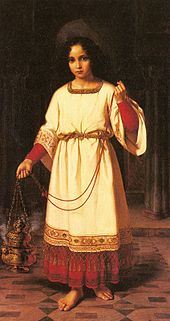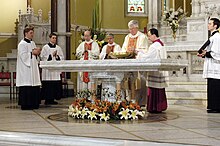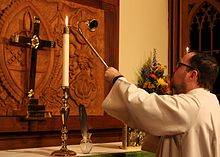
The Mass of Paul VI, also known as the Ordinary Form or Novus Ordo, is the most commonly used liturgy in the Catholic Church. It was promulgated by Pope Paul VI in 1969 and its liturgical books were published in 1970; those books were then revised in 1975, they were revised again by Pope John Paul II in 2000, and a third revision was published in 2002.

The Tridentine Mass, also known as the Traditional Latin Mass or the Traditional Rite, is the liturgy in the Roman Missal of the Catholic Church codified in 1570 and published thereafter with amendments up to 1962. Celebrated almost exclusively in Ecclesiastical Latin, it was the most widely used Eucharistic liturgy in the world from its issuance in 1570 until the introduction of the Mass of Paul VI.
Subdeacon is a minor order of ministry for men in various branches of Christianity. The subdeacon has a specific liturgical role and is placed below the deacon and above the acolyte in the order of precedence.
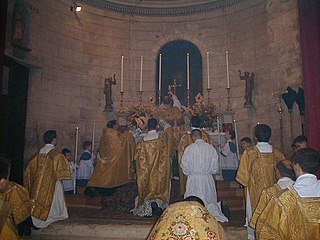
Vestments are liturgical garments and articles associated primarily with the Christian religion, especially by Eastern Churches, Catholics, Lutherans, and Anglicans. Many other groups also make use of liturgical garments; among the Reformed (Calvinist) Churches this was a point of controversy in the Protestant Reformation and sometimes since, in particular during the ritualist controversies in the Church of England in the 19th century.

An altar server is a lay assistant to a member of the clergy during a Christian liturgy. An altar server attends to supporting tasks at the altar such as fetching and carrying, ringing the altar bell, helping bring up the gifts, and bringing up the liturgical books, among other things. If young, the server is commonly called an altar boy or altar girl. In some Christian denominations, altar servers are known as acolytes.
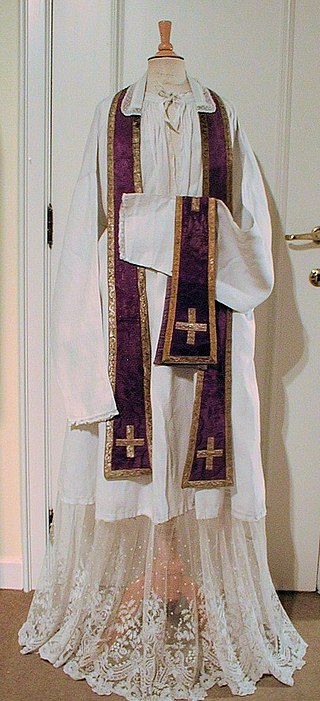
The stole is a liturgical vestment of various Christian denominations, which symbolizes priestly authority; in Protestant denominations which do not have priests but use stoles as a liturgical vestment, however, it symbolizes being a member of the ordained. It consists of a band of colored cloth, usually of silk, about seven and a half to nine feet long and three to four inches wide, whose ends may be straight or may broaden out in the shape of a spade or bell. The center of the stole is worn around the back of the neck and the two ends hang down parallel to each other in front, either attached to each other or hanging loose. The stole is almost always decorated in some way, usually with two crosses, or sometimes another significant religious design. It is often decorated with contrasting galloons and fringe is usually applied to the ends of the stole following Numbers 15:38–39. A piece of white linen or lace may be stitched onto the back of the collar as a sweat guard, which can be replaced more cheaply than the stole itself.
In Christianity, minor orders are ranks of church ministry. In the Catholic Church, the predominating Latin Church formerly distinguished between the major orders —priest, deacon and subdeacon—and four minor orders—acolyte, exorcist, lector, and porter. In 1972, the Vatican re-titled the minor orders as "ministries", with those of lector and acolyte being kept throughout the Latin Church. In the Eastern Orthodox Church, the three minor orders in use are those of subdeacon, reader and chanter.

For some centuries the Catholic Church distinguished between major orders, which the Council of Trent also called holy orders, and minor orders. The Catechism of the Council of Trent spoke of the "several distinct orders of ministers, intended by their office to serve the priesthood, and so disposed, as that, beginning with the clerical tonsure, they may ascend gradually through the lesser to the greater orders", and stated:
Their number, according to the uniform and universal doctrine of the Catholic Church, is seven, Porter, Reader, Exorcist, Acolyte, Sub-deacon, Deacon and Priest. ... Of these, some are greater, which are called "Holy", some lesser, which are called "Minor Orders". The great or Holy Orders are Sub-deaconship, Deaconship and Priesthood; the lesser or Minor Orders are Porter, Reader, Exorcist, and Acolyte.

A crucifer or cross-bearer is, in some Christian churches, a person appointed to carry the church's processional cross, a cross or crucifix with a long staff, during processions at the beginning and end of the service.

The sticharion is a liturgical vestment of the Eastern Orthodox and Eastern Catholic Churches, roughly analogous in function to the alb of the Western Church. The sticharion is worn by all classes of ordained ministers in the Constantinopolitan Rite and comes in two forms: one worn by priests and one worn by deacons and other altar servers.

The Orarion is the distinguishing vestment of the deacon and subdeacon in the Eastern Orthodox Church, Oriental Orthodox Churches and Eastern Catholic Churches. It is a narrow stole, usually four to five inches (127 mm) wide and of various lengths, made of brocade, often decorated with crosses embroidered or appliquéd along its length. It is usually trimmed with decorative banding around the edges and fringe at the two ends.

In some Christian denominations, a reader or lector is the person responsible for reading aloud excerpts of scripture at a liturgy. In early Christian times the reader was of particular value due to the rarity of literacy.

An extraordinary minister of Holy Communion in the Catholic Church is, under the 1983 Code of Canon Law, "an acolyte, or another of Christ's faithful deputed", in certain extraordinary circumstances, to distribute Holy Communion. The term "extraordinary" distinguishes such a person from the ordinary minister of Holy Communion, namely a bishop, priest or deacon. Under ordinary circumstances, only bishops, priests, and deacons may distribute Communion in the Catholic Church.

Solemn Mass is the full ceremonial form of a Mass, predominantly associated with the Tridentine Mass where it is celebrated by a priest with a deacon and a subdeacon, requiring most of the parts of the Mass to be sung, and the use of incense. It is also called High Mass or Solemn High Mass.

The Mass is the central liturgical service of the Eucharist in the Catholic Church, in which bread and wine are consecrated and become the body and blood of Christ. As defined by the Church at the Council of Trent, in the Mass "the same Christ who offered himself once in a bloody manner on the altar of the cross, is present and offered in an unbloody manner". The Church describes the Mass as the "source and summit of the Christian life", and teaches that the Mass is a sacrifice, in which the sacramental bread and wine, through consecration by an ordained priest, become the sacrificial body, blood, soul, and divinity of Christ as the sacrifice on Calvary made truly present once again on the altar. The Catholic Church permits only baptised members in the state of grace to receive Christ in the Eucharist.
Pontifical vestments, also referred to as episcopal vestments or pontificals, are the liturgical vestments worn by bishops in the Catholic, Eastern Orthodox, Oriental Orthodox, Anglican, and some Lutheran churches, in addition to the usual priestly vestments for the celebration of the mass, other sacraments, sacramentals, and canonical hours. The pontifical vestments are only worn when celebrating or presiding over liturgical functions. As such, the garments should not be confused with choir dress, which are worn when attending liturgical functions but not celebrating or presiding.

The 1983 Code of Canon Law, also called the Johanno-Pauline Code, is the "fundamental body of ecclesiastical laws for the Latin Church". It is the second and current comprehensive codification of canonical legislation for the Latin Church of the Catholic Church. The 1983 Code of Canon Law was promulgated on 25 January 1983 by John Paul II and took legal effect on the First Sunday of Advent 1983. It replaced the 1917 Code of Canon Law which had been promulgated by Benedict XV on 27 May 1917.
In the Roman Catholic Church, the term minister is used with various meanings. Most commonly, the word refers to a person, either lay or ordained, who is commissioned to perform some act on behalf of the Catholic Church. It is not a particular office or rank of clergy, as is the case in some other Christian organisations; rather, minister may be used as a collective term for vocational or professional pastoral leaders including clergy and non-clergy. It is also used in reference to the canonical and liturgical administration of sacraments, as part of some offices, and with reference to the exercise of the lay apostolate.
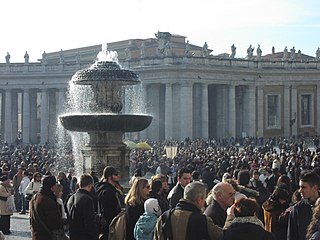
Catholic laity are the ordinary members of the Catholic Church who are neither clergy nor recipients of Holy Orders or vowed to life in a religious order or congregation. Their mission, according to the Second Vatican Council, is to "sanctify the world".
Spiritus Domini is an apostolic letter in the form of a motu proprio by Pope Francis signed on 10 January 2021 and released the next day. It changed the 1983 Code of Canon Law to allow women to be admitted to the instituted ministries of acolyte and lector (reader), which had until then been exclusively available to men.
